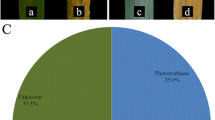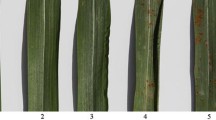Abstract
Of the 16 known biotypes of the Hessian fly [Mayetiola destructor (Say)], biotype L is recognized as being the most virulent. We have previously reported the development of near-isogenic lines (NILs) (BC3F3:4) by backcross introgression (Coker797*4/Hamlet) that differed by the presence or absence of the H21 gene on 2RL chromatin. Florescence in situ hybridization analysis revealed introgressed 2RLs in NILs possessing the H21 gene, but no signal was detected in NILs lacking 2RL. As part of an approach to elucidate molecular interactions between plants and the Hessian fly, a cDNA library from NILs with H21 infested by larvae of biotype L of the Hessian fly was constructed for expressed sequence tag (EST) analysis. Of 1,056 sequenced reactions attempted, 919 ESTs produced some lengths of readable sequences. Based on their putative identification, 730 ESTs that showed significant similarity with amino acid sequences registered in the gene bank were divided into 13 functional categories. Defense- and stress-related genes represented about 16.1%, including protease inhibition, oxidative burst, lignin synthesis, and phenylpropanoid metabolism. EST clones obtained from the cDNA library may provide a clue to the molecular interactions between plant and larva of the Hessian fly larval infestation.

Similar content being viewed by others
Abbreviations
- ESTs :
-
Expressed sequence tags
- FISH :
-
Florescence in situ hybridization
- NILs :
-
Near-isogenic lines
References
Able AJ, Guest DI, Sutherland MW (2000) Hydrogen peroxidase yields during the incompatible interaction of tobacco suspension cells inoculated with Phytophthora nicotianae. Plant Physiol 124:899–910
Baldwin IT, Preston C (1999) The eco-physiological complexity of plant response to insect herbivores. Planta 208:137–145
Baldwin IT, Halitschke R, Kessler A, Schittko U (2001) Merging molecular and ecological approaches in plant-insect interactions. Curr Opin Plant Biol 4:351–358
Capellades M, Torres MA, Bastisch I, Stiefel V, Vignols F, Bruce WB, Peterson D, Puigdomènech P, Rigau J (1996) The maize caffeic acid O-methyltransferase gene promoter is active in transgenic tobacco and maize plant tissues. Plant Mol Biol 31:307–322
Channelière S, Rivière S, Scalliet G, Szecsi J, Jullien F, Dolle C, Vergne P, Dumas C, Bendahmane M, Hugueney P, Cock JM (2002) Analysis of gene expression in rose petals using expressed sequence tags. FEBS Lett 515:35–38
Constabel CP (1999) Induced plant defenses against pathogens and herbivores. In: Agrawal AA, Tuzun S, Bent E (eds) A survey of herbivore-inducible defensive proteins and phytochemicals. APS Press, St. Paul, Minn., pp 137–166
Constabel CP, Yip L, Patton JJ, Christopher ME (2000) Polyphenol oxidase from hybrid poplar. Cloning and expression in response to wounding and herbivory. Plant Physiol 124:285–295
Covitz PA, Smith LS, Long SR (1998) Expressed sequence tags from a root-hair-enriched Medicago truncatula cDNA library. Plant Physiol 117:1325–1332
Doke N (1983) Involvement of an O2 - generating system in the induction of necrotic lesions on tobacco mosaic virus. Physiol Mol Plant Pathol 32:163–175
Friebe B, Hatchett JH, Sear RG, Gill BS (1990) Transfer of Hessian fly resistance from 'Chaupon' rye to hexaploid wheat via 2BS/2RL wheat-rye chromosome translocation. Theor Appl Genet 79:385–389
Györgyey J, Vaubert D, Jimenez-Zurdo JI, Charon C, Troussard L, Kondorosi A, Kondoros E (2000) Analysis of Medicago truncatula nodule expressed sequence tags. Mol Plant Microbe Interact 13:62–71
Hermsmeier D, Schittko U, Bladwin IT (2001) Molecular interactions between the specialist herbivore Manduca sexta (Lepidoptera, Sphingidae) and its natural host Nicotiana attenuata. I. Large-scale change in the accumulation of growth- and defense-related plant mRNAs. Plant Physiol 125:683–700
Jang CS, Hong BH, Seo YW (1999) Expressed sequence tags of the wheat-rye translocation line possessing 2RL. Korean J Crop Sci 44:302–307
Jang CS, Kim DS, Bu SY, Kim JB, Lee SS, Kim JY, Johnson JW, Seo YW (2002) Isolation and characterization of lipid transfer protein (LTP) genes from a wheat-rye translocation line. Plant Cell Rep 20:961–966
Kader JC (1996) Lipid transfer proteins in plants. Annu Rev Plant Physiol Plant Mol Biol 47:627–654
Koebner RMD, Shepherd KW (1986) Controlled introgression to wheat of genes from rye chromosome arm 1RS by induction of allosyndesis. 1. Isolation of recombinants. Theor Appl Genet 73:197–208
Kolomiets MV, Richard HC, Braun GEJ, Hannapel DJ (2000) A leaf lipoxigenase of potato induced specifically by pathogen infection. Plant Physiol 124:1121–1130
Korth KL, Dixon RA (1997) Evidence for chewing insect-specific molecular events distinct from a general wounding response in leaves. Plant Physiol 115:1299–1305
Lewis NG, Yammamoto E (1990) Lignin: occurrence, biogenesis and biodegradation. Annu Rev Plant Physiol Plant Mol Biol 41:455–496
Mittler R, Lam E, Shulaev V, Cohen M (1999) Signals controlling the expression of cytosolic ascobate peroxidase during pathogen-induced programmed cell death in tobacco. Plant Mol Biol 39:1025-1035
Molina A, Diaz I, Vasil IK, Carbonero P, Garcia-Olmedo F (1996) Two cold-inducible genes encoding lipid transfer protein LTP4 from barley show differential response to bacterial pathogens. Mol Gen Genet 252:162–168
Newman T, De Bruijin FJ, Green P, Keegstra K, Kende H, McIntosh L, Ohlrogge J, Raikhel N, Somerville S, Thomashow M, Retzel E, Somerville C (1994) Genes galore. A summary of methods for accessing results from large-scale partial sequencing of anonymous Arabidopsis cDNA clones. Plant Physiol 106:1241–1255
Patterson FL, Foster JE, Ohm HW, Hatchett JH, Taylor PL (1992) Proposed system on nomenclature or biotypes of Hessian fly (Diptera: Cecidomyiidae) in North America. J Econ Entomol 85:307–311
Pearce RS, Houlston CE, Atherton KM, Rixon JE, Harrison P, Hughes MA, Dunn MA (1998) Localization of expression of three cold-induced genes, blt101, blt4.9, and blt14, in different tissues of the crown and developing leaves of cold-acclimated cultivated barley. Plant Physiol 117:787–795
Ryan CA (1990) Protease inhibitors in plants: genes for improving defense against insects and pathogens. Annu Rev Phytopathol 28:425–449
Reymond P, Weber H, Damond M, Farmer E (2000) Differential gene expression in response to mechanical wounding and insect feeding in Arabidopsis. Plant Cell 12:707–719
Saghai-Maroof MA, Soliman KM, Jorgenson RA (1984) Ribosomal DAN length polymorphism in barley: Mendelian inheritance. Chromosomal location and population dynamics. Proc Natl Acad Sci USA 81:8014–8018
Sear RG, Hatchett JH, Cox TS, Gill BS (1992) Registration of Hamlet, a Hessian fly resistant hard red winter wheat germplasm. Crop Sci 32:506
Seo YW, Johnson JW, Jarret RL (1997) A molecular marker associated with the H21 Hessian fly resistance gene in wheat. Mol Breed 3:177–181
Seo YW, Jang CS, Johnson JW (2001) Development of AFLP and STS markers for identifying wheat-rye translocations possessing 2RL. Euphytica 121:279–287
Van der Ven WTG, LeVesque CS, Perring TM, Walling LL (2000) Local and systemic changes in squash gene expression in response to silverleaf whitefly feeding. Plant Cell 12:1409–1423
Zhang L, Ma XL, Zhang Q, Ma CL, Wang PP, Sun YF, Zhao YX, Zhang H (2001) Expressed sequence tags from a NaCl-treated Suaeda salas cDNA library. Gene 267:193–200
Ziegler J, Keinänen M, Baldwin IT (2001) Herbivore-induced allene oxide synthase transcripts and jasmonic acid in Nicotinana attenuata. Phytochemistry 58:729–738
Acknowledgements
The authors extend special thanks to Dr. Robert A. Graybosch (USDA-ARS, University of Nebraska-Lincoln) for his thoughtful comments and suggestions on the manuscript and Drs. Rogers H. Ratcliffel and Sue E. Cambron (University of Purdue) for providing Hessian fly stocks. This work was supported by a grant from the BioGreen 21 Program, Rural Development Administration, Republic of Korea. It was also partially funded by a Korea University Grant.
Author information
Authors and Affiliations
Corresponding author
Additional information
Communicated by P. Puigdoménech
All of the EST sequence data reported will appear in the dbEST and GenBank database (accession numbers CB307016 to CB307934)
Rights and permissions
About this article
Cite this article
Jang, C.S., Kim, J.Y., Haam, J.W. et al. Expressed sequence tags from a wheat-rye translocation line (2BS/2RL) infested by larvae of Hessian fly [Mayetiola destructor (Say)]. Plant Cell Rep 22, 150–158 (2003). https://doi.org/10.1007/s00299-003-0641-6
Received:
Revised:
Accepted:
Published:
Issue Date:
DOI: https://doi.org/10.1007/s00299-003-0641-6




